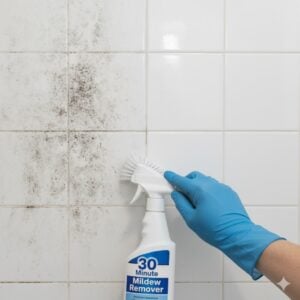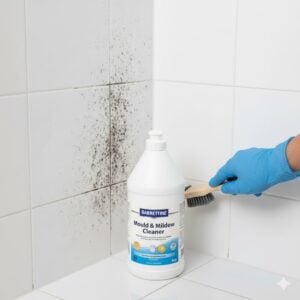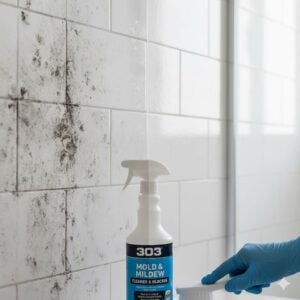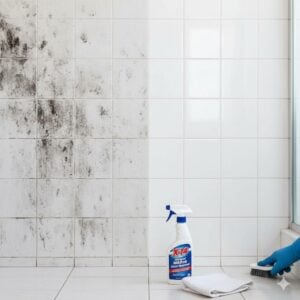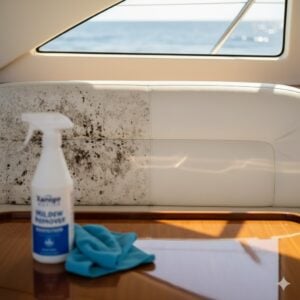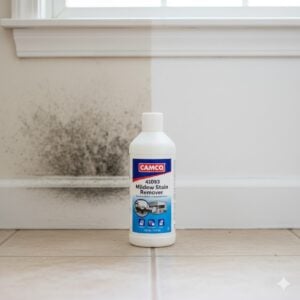Seeing black spots on the wall can be worrying—especially if they keep coming back after you wipe them. In UAE homes and offices, these spots usually point to moisture and ventilation issues made worse by constant AC use and sealed windows. Sometimes it’s just dust or soot; other times it’s active mold. In this guide, we explain how to tell the difference, what the risks are, and the safest ways to clean and stop the problem for good—so you can protect your health and your property.
Table of Contents
Toggle1. What those black spots on the wall usually are (and how to tell)

Black spotting has several common causes. Identifying the right one helps you choose the correct fix:
- Mold/mildew (most common): Appears as clusters or speckles that can look fuzzy or slimy, often with a musty smell. Loves bathrooms, ceilings above showers, around AC vents, behind wardrobes, and cold corners where condensation forms.
- Soot/“ghosting” from AC, candles, or cooking: Very fine gray-black dust that settles on cold walls or where air flows. It smears easily when wiped. You’ll often see dark lines along studs, nails, or ceiling edges (thermal bridges).
- Dirt/dust deposition: Uniform film that wipes off cleanly. Often appears where hands touch walls, near vents, or in high-traffic hallways.
- Insect spots: Tiny pepper-like dots (often on ceilings or near lights). Usually discrete specks, not fuzzy, and no musty odor.
- Water damage staining: Dark or yellow-brown marks with tide lines, peeling paint, or bubbling plaster. Can coexist with mold if dampness persists.
Quick checks you can do:
- Smell: A persistent musty odor points to mold, not soot or dust.
- Wipe test: If a soft, dry cloth smears the spot gray/black like charcoal, think soot/ghosting. If spots remain embedded or feel slimy, think mold.
- Pattern: Patchy clusters in damp zones = likely mold. Straight lines along studs, nails, or ceiling edges = soot/thermal ghosting.
2. Is it dangerous? Health and property risks you should know
Mold-related black spots can release spores that irritate the airways and skin. Sensitive groups—children, elderly, asthma/allergy sufferers—may notice:
- Sneezing, coughing, wheezing, or congested nose
- Itchy eyes/skin or headaches that improve when you leave home
- Aggravated asthma or recurrent sinus issues
Beyond health, mold gradually damages paint, plaster, wood, and fabrics. If left unchecked, it can spread into hidden cavities (behind drywall or inside wardrobes) and become costly to fix. Even non-mold causes like soot/ghosting matter: they indicate ventilation or thermal-bridging problems that stain finishes and shorten paint life.
Important: This article is for guidance—not medical advice. If anyone at home has persistent symptoms, consider speaking with a healthcare professional while you address the indoor issue.
3. Safe cleaning: what you can DIY (and what to avoid)
For small areas (up to ~1 sq.m.) and if the wall is non-porous (tile, sealed paint), DIY cleaning can be enough. Work methodically and safely:
- Protect yourself & ventilate: Wear gloves and a simple mask (at least a disposable respirator). Open windows/doors and run exhaust fans. Keep kids and pets out.
- Dry wipe first (if soot/dust): Using a dry microfiber cloth or vacuum with HEPA attachment. This reduces smearing. If it wipes off easily and no musty odor, it was likely soot/dust.
- Wash (if suspected mold): Mix warm water with a few drops of mild detergent. Gently scrub the area. Rinse with clean water and dry thoroughly.
- Disinfect (optional for moldy spots): Use a ready-made, non-chlorine, mold/mildew cleaner or diluted household bleach (typical ratio: ~1 part bleach to 16 parts water). Never mix bleach with ammonia or acidic cleaners. Apply, wait per label, rinse, then dry well.
- Prime & repaint (if stained): After the wall is fully dry, use a stain-blocking primer. Finish with a mold-resistant paint, especially for bathrooms/ kitchens.
Avoid: Dry brushing mold (it sends spores airborne), soaking drywall (can worsen damage), and using harsh chemicals in unventilated rooms. If spots return within days or the area is large, stop DIY and call a licensed remediation team.
4. Stop it from coming back: fix the source (UAE-specific tips)
Black spots are a symptom; the cause is usually moisture + poor airflow + cold surfaces. Here’s how to break that cycle in UAE homes:
- Improve ventilation: Run bathroom/kitchen exhausts during and 20–30 minutes after use. Crack a window when humidity outside is moderate. Keep interior doors ajar for airflow.
- Mind the AC: Clean filters monthly. Ensure proper drainage (no drip or pooling). Avoid very low setpoints that cause condensation on cold walls/ceilings.
- Create breathing space: Keep wardrobes/sofas 5–8 cm off exterior walls so air can circulate behind them. Avoid packing closets tightly.
- Control humidity: Use a dehumidifier in persistently damp rooms (target ~45–55% RH). Quickly dry shower walls/ floors with a squeegee.
- Fix leaks fast: Under-sink, behind washing machines, around windows, and near water heaters. Check for hairline cracks or failed sealant.
- Insulate cold spots: Recurrent “ghosting” lines along studs or ceiling edges indicate thermal bridging; better insulation, vapor barriers, or anti-condensation coatings help.
- Choose smart coatings: Use mold-resistant paints/primers in bathrooms, kitchens, laundries, and near AC vents.
These steps are not cosmetic—they reduce the actual conditions mold needs (moisture + still air + cool surfaces). Done together, they dramatically cut recurrence.
5. When to call a professional (and realistic UAE costs)
It’s time to bring in experts if any of the following apply:
- The affected area is larger than ~1–3 sq.m., or keeps spreading
- You see black spots on ceilings near AC vents or smell mustiness in multiple rooms
- Paint is bubbling/peeling, or there’s clear water damage
- Family members have persistent allergy/asthma symptoms at home
- You’ve cleaned it more than once and it returns within days/weeks
What professional remediation includes: moisture/source diagnosis, safe containment (to prevent spore spread), HEPA filtration, targeted cleaning or removal of compromised materials, disinfection, and a prevention plan (ventilation, humidity, coatings). As a municipality-authorized team, we focus on both the visible issue and the root cause, so you don’t fight the same spots again next month.
Transparent Bio-On pricing in the UAE (mold/black spots):
| Volume of Work | AED per sq.m./running meter | AED per 10.76 sq.ft / 3.28 linear ft |
|---|---|---|
| Up to 1 sq.m. | 35 | 35 |
| From 1 to 3 sq.m. | 30 | 30 |
| From 3 to 7 sq.m. | 25 | 25 |
| From 7 to 10 sq.m. | 20 | 20 |
| More than 10 sq.m. | Free inspection | Free inspection |
Advanced identification (for stubborn or health-critical cases): Air Quality Testing, Surface Scraping (Microscopic Analysis), Mycotoxin Analysis, PCR Analysis, Humidity & pH Level Measurement, and Sample Analysis—each AED 1000. We only recommend lab work when it genuinely adds value (e.g., unexplained symptoms, recurrent growth, or landlord/insurance documentation).
Conclusion
Black spots on walls are not “just dirt.” In many UAE homes they signal moisture, condensation, or airflow problems that will keep causing stains—and possibly health symptoms—until the source is fixed. For small, non-porous surfaces, you can clean safely and watch for recurrence. If the spots return, spread, or carry a musty odor, it’s smarter (and usually cheaper long-term) to solve the root cause with professional help.
If you want a quick, honest assessment of your situation, just click the contact button on the right-middle of this post. We can inspect, clean, and help you prevent those black spots from coming back—for good.








